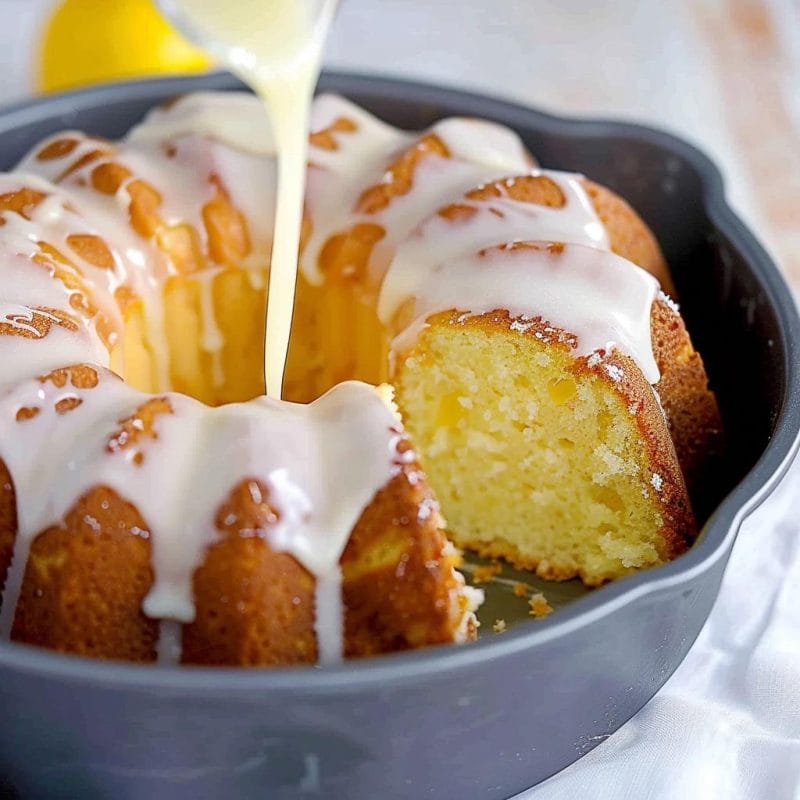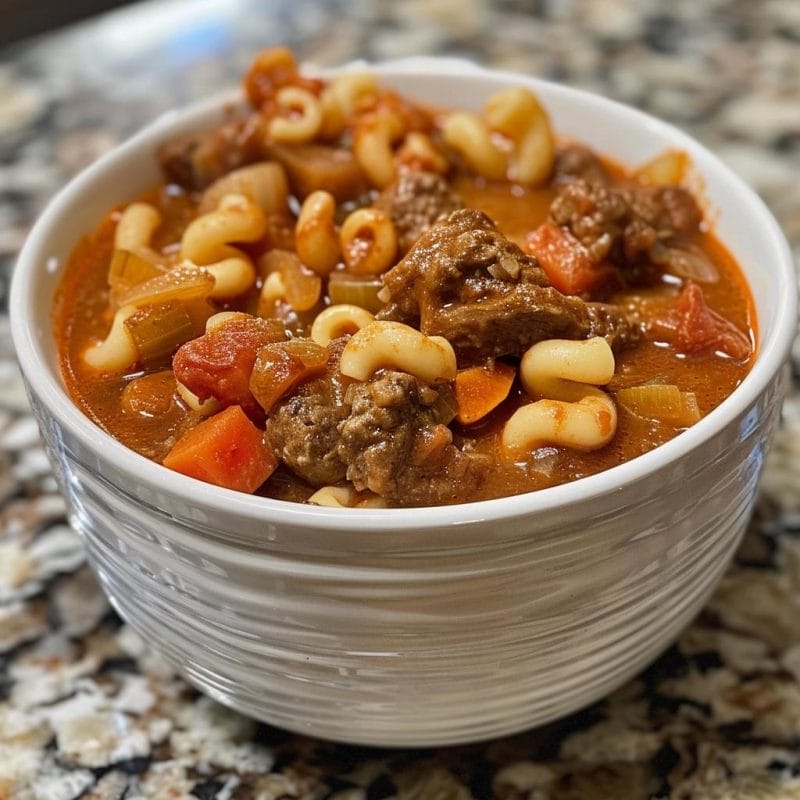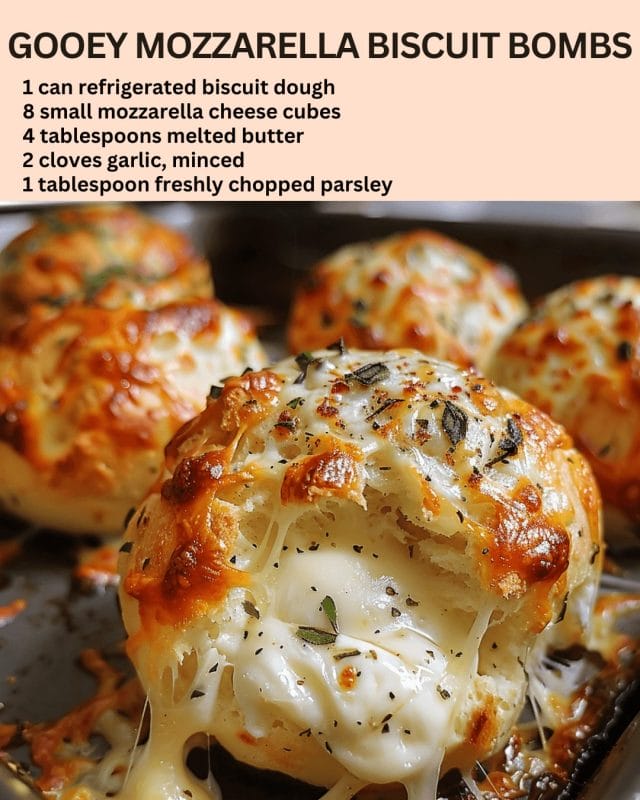Would you like to save this?
I first discovered this recipe during a summer family reunion. My aunt, known for her knack for creating delectable desserts, brought this cake along, and it quickly became the highlight of the dessert table. The cake’s golden exterior and luscious glaze drew everyone in, and the first bite revealed a moist, citrusy goodness that had us all coming back for seconds. This cake not only pleased our taste buds but also sparked a tradition of baking it for every special occasion. It’s a recipe that embodies the essence of family gatherings, bringing joy and a touch of nostalgia with every slice.
Ingredients
For the Cake:
1 (15.25-ounce) box yellow cake mix
1 (3.4-ounce) box instant lemon pudding mix
3/4 cup vegetable oil
3/4 cup orange juice
4 large eggs
For the Glaze:
2 cups powdered sugar
3/4 cup orange juice
4 tablespoons unsalted butter
Instructions
Step 1: Preparing the Oven and Pan
Preheat Your Oven:
Begin by preheating your oven to 350°F (175°C). This ensures that your cake bakes evenly and achieves a perfect golden color.
Prepare the Bundt Pan: Grease and flour a 10 to 12-cup Bundt pan. This step is crucial as it prevents the cake from sticking to the pan and ensures that it comes out in one beautiful piece. You can use a non-stick spray or rub the pan with butter, followed by a light dusting of flour.
Step 2: Mixing the Cake Batter
Combine the Ingredients:
In a large mixing bowl, combine the yellow cake mix and instant lemon pudding mix. These pre-made mixes simplify the process, ensuring a moist and flavorful cake with minimal effort.
Add Wet Ingredients: Add the vegetable oil, orange juice, and eggs to the dry ingredients. Using an electric mixer, beat the mixture on medium speed for about 2 minutes. The batter should be well combined and smooth. This step is where the magic happens—the citrus from the orange juice and the richness of the eggs and oil create a perfect cake batter.
Pour into the Pan: Carefully pour the cake batter into the prepared Bundt pan. Smooth the top with a spatula to ensure an even bake.
Step 3: Baking the Cake
Bake to Perfection:
Place the Bundt pan in the preheated oven and bake for 35 to 40 minutes. Check for doneness by inserting a toothpick into the center of the cake. It should come out clean, and the edges of the cake should start to pull away from the sides of the pan. The cake will have a lovely golden brown color.
Cool the Cake: Allow the cake to cool in the pan for about 10 minutes. This helps it set and makes it easier to remove from the pan without breaking. After cooling slightly, use a cake knife to gently loosen the edges of the cake if needed, then invert the pan onto a wire rack or plate.
Step 4: Making the Glaze
Prepare the Glaze:
In a small saucepan, combine the powdered sugar, orange juice, and unsalted butter. Cook over medium-low heat, stirring frequently, until the butter has melted and the glaze is smooth and well combined. This glaze is the finishing touch that adds a sweet and tangy layer of flavor to the cake.
Glaze the Cake: Use a skewer or toothpick to poke holes all over the top of the cake while it’s still in the pan. This allows the glaze to seep into the cake, enhancing its flavor and moistness. Pour the warm glaze over the cake slowly. It may seem like a lot of glaze, but trust the process—keep pouring until the cake has absorbed as much as possible.
Cool Completely: Allow the cake to cool for an additional 15 to 20 minutes in the pan after glazing. This cooling period lets the glaze set and absorb into the cake. After this time, carefully invert the cake onto a serving platter. Let it cool completely before slicing and serving.
Variations and Substitutions
Fruit Additions:
For an extra burst of flavor, consider adding small pieces of fresh fruit such as blueberries or raspberries to the batter before baking. These fruits pair beautifully with the citrus notes of the orange juice.
Flavor Enhancements: If you prefer a more pronounced citrus flavor, add a teaspoon of orange zest to the cake batter. This will enhance the orange aroma and add a fresh, zesty note.
Gluten-Free Option: To make this recipe gluten-free, substitute the yellow cake mix with a gluten-free cake mix. Ensure that all other ingredients, especially the pudding mix, are gluten-free.
Reduced Sugar: For a lighter version, reduce the amount of powdered sugar in the glaze or use a sugar substitute. You can also use reduced-fat cream cheese in place of some of the butter to cut down on fat content.
Conclusion
Orange Juice Cake is more than just a dessert—it’s a celebration of simple ingredients coming together to create something truly special. The blend of tangy orange juice and creamy lemon pudding mix delivers a cake that’s both moist and bursting with flavor. The sweet, citrusy glaze adds a finishing touch that turns each slice into a memorable treat.
This cake is perfect for any occasion, from casual family dinners to festive gatherings. Its bright flavor and delightful texture make it a crowd-pleaser, while its simplicity ensures that it’s easy to prepare. Whether you’re a seasoned baker or a kitchen novice, Orange Juice Cake is a recipe that’s sure to impress and bring joy to your table.
So, preheat your oven, gather your ingredients, and enjoy the process of creating a cake that’s not only delicious but also a joyful reminder of the pleasure that comes from baking and sharing homemade treats.







